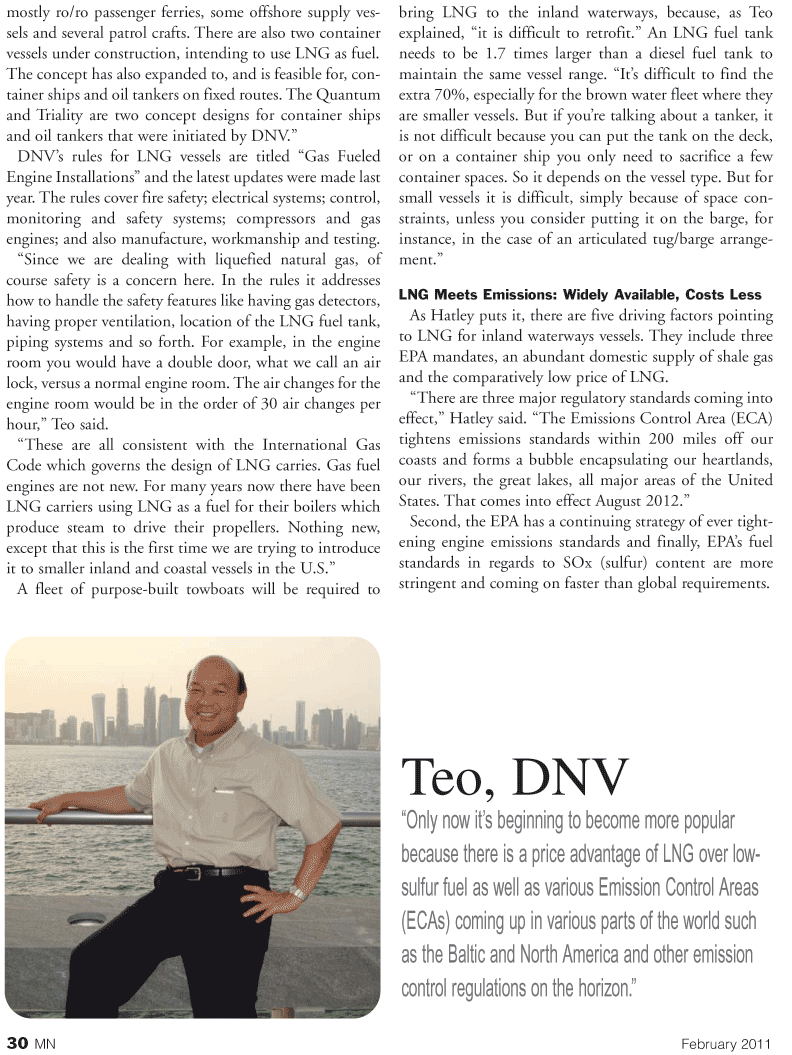
Page 30: of Marine News Magazine (February 2011)
Inland Waterways
Read this page in Pdf, Flash or Html5 edition of February 2011 Marine News Magazine
30 MN February 2011 mostly ro/ro passenger ferries, some offshore supply ves- sels and several patrol crafts. There are also two container vessels under construction, intending to use LNG as fuel.
The concept has also expanded to, and is feasible for, con- tainer ships and oil tankers on fixed routes. The Quantum and Triality are two concept designs for container ships and oil tankers that were initiated by DNV.”
DNV’s rules for LNG vessels are titled “Gas Fueled
Engine Installations” and the latest updates were made last year. The rules cover fire safety; electrical systems; control, monitoring and safety systems; compressors and gas engines; and also manufacture, workmanship and testing. “Since we are dealing with liquefied natural gas, of course safety is a concern here. In the rules it addresses how to handle the safety features like having gas detectors, having proper ventilation, location of the LNG fuel tank, piping systems and so forth. For example, in the engine room you would have a double door, what we call an air lock, versus a normal engine room. The air changes for the engine room would be in the order of 30 air changes per hour,” Teo said. “These are all consistent with the International Gas
Code which governs the design of LNG carries. Gas fuel engines are not new. For many years now there have been
LNG carriers using LNG as a fuel for their boilers which produce steam to drive their propellers. Nothing new, except that this is the first time we are trying to introduce it to smaller inland and coastal vessels in the U.S.”
A fleet of purpose-built towboats will be required to bring LNG to the inland waterways, because, as Teo explained, “it is difficult to retrofit.” An LNG fuel tank needs to be 1.7 times larger than a diesel fuel tank to maintain the same vessel range. “It’s difficult to find the extra 70%, especially for the brown water fleet where they are smaller vessels. But if you’re talking about a tanker, it is not difficult because you can put the tank on the deck, or on a container ship you only need to sacrifice a few container spaces. So it depends on the vessel type. But for small vessels it is difficult, simply because of space con- straints, unless you consider putting it on the barge, for instance, in the case of an articulated tug/barge arrange- ment.”
LNG Meets Emissions: Widely Available, Costs Less
As Hatley puts it, there are five driving factors pointing to LNG for inland waterways vessels. They include three
EPA mandates, an abundant domestic supply of shale gas and the comparatively low price of LNG. “There are three major regulatory standards coming into effect,” Hatley said. “The Emissions Control Area (ECA) tightens emissions standards within 200 miles off our coasts and forms a bubble encapsulating our heartlands, our rivers, the great lakes, all major areas of the United
States. That comes into effect August 2012.”
Second, the EPA has a continuing strategy of ever tight- ening engine emissions standards and finally, EPA’s fuel standards in regards to SOx (sulfur) content are more stringent and coming on faster than global requirements.
Teo, DNV “Only now it’s beginning to become more popular because there is a price advantage of LNG over low- sulfur fuel as well as various Emission Control Areas (ECAs) coming up in various parts of the world such as the Baltic and North America and other emission control regulations on the horizon.”

 29
29

 31
31
